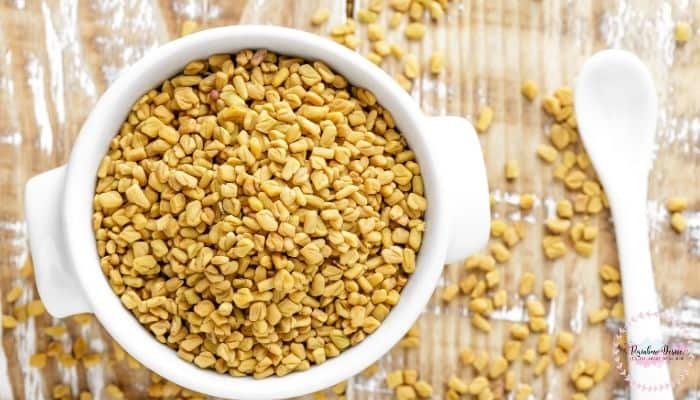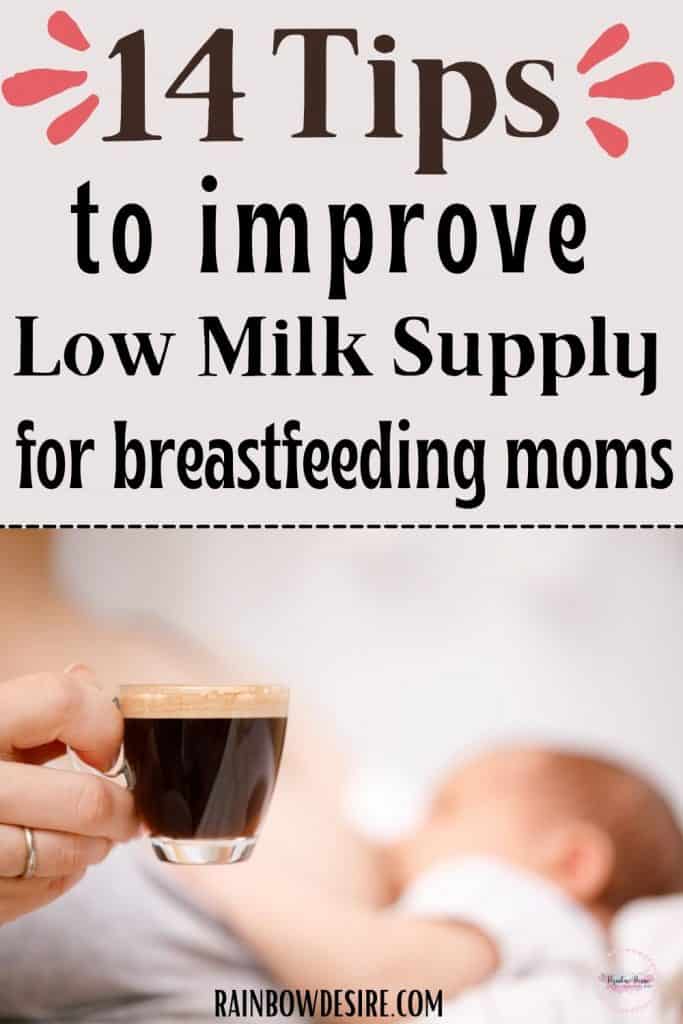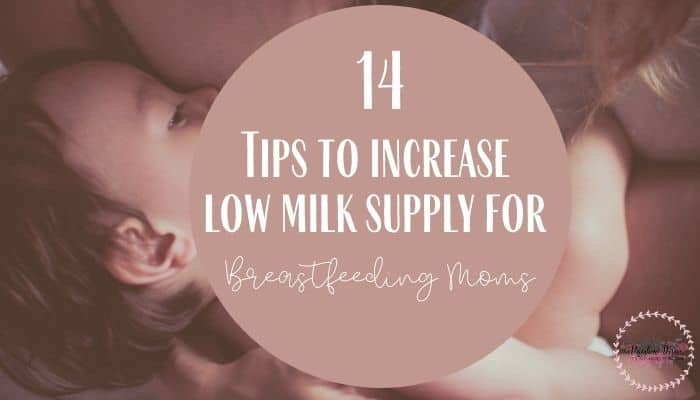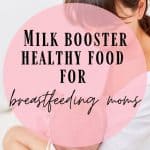Breastmilk comes in naturally for moms after giving birth, but not every mom produces the same amount of milk. Dealing with a low milk supply is a common problem that many moms have to face at some point in their breastfeeding journey.
Mother feed is widely known to make babies smarter and improve their immunity naturally. Breastfeeding helps in gaining a healthy weight for the newborns and also helps moms to shed some post-baby weight faster.
Breastfeeding encourages healthy hormones in your body. These hormones help in reducing your pregnancy weight and lessens the risk of postpartum depression. If you’re struggling to increase your milk supply, this post will be super helpful for moms, especially after a C-section delivery.
This post may contain affiliate links. Please read our disclaimer for more information.
Best Tips to increase Low milk supply for breastfeeding moms
These amazing tips will help you increase your milk supply faster. In this post, we are talking about lactogenic food and some other non-food items that can significantly increase milk production for nursing moms.
1. Massaging Breasts
After the baby is born, your breast produces colostrum, a thicker form of milk. Colostrum produced initially is yellow in color, has high proteins and low sugar valuable nutrition for the infant. The transitional milk comes next after colostrum, and massaging your breasts with a warm moist towel helps with milk letdown.

Apply both hot and moist compresses to increase the flow of breast milk naturally at home. The correct way to massage is by using your fingertips, beginning in a circular motion from the top of your breast, and coming towards the nipple to stimulate the milk course.
Warm towel massage, hot showers, and warm compresses are ideal for mothers before breastfeeding.
How to do warm towel massage?
Take a hand towel or washcloth, and soak it in a little over warm water. Wring it to remove excess water and massage your breast with this warm moist towel. This massage would help with the milk flow and the letdown process starts sooner.
Check out this hot warm towel steamer you can have at home for a hassle-free hand towel massage.
Gently massaging breasts helps significantly with low milk supply. Lavie Breast massager can help improve low milk production and relieve clogged milk ducts, mastitis, and other nursing issues.
2. Eating the Right Food
Eating a balanced diet to increase breast milk supply is equally essential. Some of the best foods to include in your diet are:

- Barley increases the production of prolactin, also called the breastfeeding hormone.
- The combination of fenugreek seeds, fennel seeds, and cumin seeds are believed and researched to show an increase in milk production. Cumin and fenugreek seeds are widely used, in Asian countries for ages.
- Oats, whole wheat, and rice (brown) contain beta-glucan in abundance, which is famous for increasing milk production.
- Papaya and foods like apricots, asparagus, anise seeds, caraway seeds, coriander seeds, dill, garlic, poppy seed, and red beets are called lactogenic foods – Consuming lactogenic food helps improve milk supply for breastfeeding moms.
Moreover, the intake of spinach and other green leafy veggies is good for nursing mothers to boost their healthy milk supply. Some mothers might also use lactation supplements to increase milk production as their babies grow.
Some of the best choices for supplementation are:
Fenugreek Lactation supplements
Milk dust Protein Powder for improved milk production and weight loss
Related: 20+ tried and tested lactogenic food that increases milk supply fast.
11+ healthy and easy-to-make postpartum recipes and meal ideas for new moms.
3. Avoid Using Pacifiers for the First Few Weeks
New parents often get upset with an infant’s continuous crying; hence they start using a pacifier to solve the problem of low milk supply. Most doctors say a big ‘NO’ to pacifiers as using a binky too soon might create nipple confusion and the baby will have trouble latching on for breastfeeding.
Not to mention, babies need to put a lot of effort into a good latch and amp up their suckle for faster milk let down. Hence, the doctor suggests that a pacifier should be avoided in the first four to six weeks. Instead, the mothers should try and feed the babies at short intervals, monitoring the excretions and the infant’s digestion by burping them.

Related: How to help burp baby after feeding.
4. How to increase milk supply when Pumping exclusively
Initially pumping milk seems overwhelming and difficult to handle, but it is very beneficial in the long run.
In some cases of sudden milk let down mothers can hand express breast milk into a bottle. Haaka Manual Pump is a breast pump made of 100% silicone; a power pump that uses suction to pump milk. Haaka is not electrical or manual; it acts to support pull instead. By using a strong suction, the milk gets out of your breast and most importantly, you can save milk from leaking breast on the other side while nursing.
Exclusively pumping is helpful if you are a working mom. It is always best to pump from one breast and then pump from the second breast. Remember to pump milk till the breasts are completely emptied. You must use an electric pump if you are exclusively bottle feeding your breastmilk.
You must take Online Class on Pumping Breastmilk by Milkology to have yourself prepared for exclusive pumping, storing the milk, and keeping your milk supply up. At Milkology, Stacey is a lactation educator and has helped thousands of moms on their breastfeeding journey.
Enroll in an online Exclusive Pumping Class.
Using this pump-it-up lactation supplement improves low milk supply for pumping moms.

What is power pumping or electric Pumping?
Electric pumping allows hands-free pumping the breastmilk directly into the storage bag. Using an electric pump will help you produce more milk. You can store extra milk in the freezer storage bags for later use.
If you are exclusively nursing, Haaka manual pump helps in easier milk storage to make sure nothing gets wasted.
5. Feed More Often On-Demand in Short Intervals
Feeding more often is essential for the first two weeks as the more your feed your newborn, the more milk will be produced. The newborn suckling signals the hormone prolactin to be produced further triggers the brain to increase milk supply overnight.
Exclusively breastfeeding your newborn on demand would help increase milk supply faster; as your baby grows, your body will produce more milk according to your child’s needs.

Take an online breastfeeding class by Milkology
6. Empty Breasts Properly on Each Mealtime for the Baby
The infants should be breastfed after every 2 hours till they get the hang of it and latch perfectly – and your supply keeps on increasing as the baby grows. Realistically speaking, the feedings are not evenly spaced during 24 hours – throughout the day. However, the first week is the hardest for a new mother to establish the milk supply as it may take 3 to 5 days for flow to kick in.

If your baby goes to sleep after 5 minutes of feed while the regular time is 15 mins, it is essential to wake the baby up by tickling the feet or move the baby by holding the chin. The breast continuously keeps producing milk when your newborn is being nurtured.
A newborn must take a feed of 20 to 30 mins so that the baby’s stomach is full and the breast is empty. That way the brain gives the signal of producing more milk to meet the requirements of the baby.
Not to mention, emptying the breast will fix the issue of leaking breasts and pain due to engorgement.
Related: Common Breastfeeding problems and how new moms can deal with them.
7. Using Natural Supplements
The four supplements to increase milk supply strongly recommended for increasing breast milk includes
- Fenugreek: this comes in numerous forms powders, seeds, liquids, and capsules. The recommended dose is 580 to 610 mg per day as needed. The positive results might be noticed in 24 to 72 hours.
- Fennel is a nutritious food available in different forms and combinations to support a breastfeeding mother and is an essential ingredient to promote lactation.
- Palm Dates: are rich in zinc, magnesium, copper, selenium, potassium, Vitamin-C, B-complex vitamins and have increased fiber content.
- Coleus Amboinicus: is used in Chinese cooking and given for increasing woman’s milk supply.

Semolina pudding is a healthy snack for breastfeeding moms and their babies. Add some of your favorite nuts like almonds, pistachio, coconut, raisins, or walnuts for extra flavor and benefits.
8. Milk Tea
Milk tea is a special supplement prepared by herbs to increase milk production in breastfeeding mothers. This tea is a herbal remedy to help with a low milk supply. To prepare this at home you need coriander (210 mg), blessed thistle (35 mg), fennel (560 mg), fenugreek (35 mg), and anise (350 mg). This tea can be consumed 3 to 5 times a day depending on the need to improve milk supply.
Here are some amazing Milk teas that have been beneficial for improving milk supply.
Earth Mama’s organic milkmaid tea.
Milk dust protein powder ensures increased milk supply and weight loss.

9. Staying Well Hydrated
Did you know that experts have suggested drinking at least 128 ounces of fluid a day when you are breastfeeding?
Water alone helps regulate so many body functions. Drinking a sufficient amount of water is essential when you are breastfeeding, as 90 percent of breast milk is water.
Bone broth is an ideal diet for new moms, especially after a C-section. It gives new moms nutritious hydration and helps them recover faster after giving birth.

Check out this water bottle that keeps you motivated to stay hydrated.
Avoid Mistakes that Slow Down Milk Production
1. Feeding on long stretches
Newborn babies need to be fed every two hours or on-demand during the day. Nursing your baby on long stretches, like 3 to 4 hours, reduces the milk supply significantly. If you are overproducing milk, pump and store it for bottle feeding.
Also, feeding according to a timetable or a rigid feeding routine can lead to low supply. A mother’s body does not act as a clock;-it does not manufacture milk during the day at a steady rate.
2. Supplementing with formula feeding
Offering a formula bottle at night or missing nighttime feedings, showing the absence of breastfeeding demands eventually results in a lower milk supply. In addition to that, allowing the baby to sleep while nursing when your breasts are still full of milk, sure reduces the milk supply.
When the breasts do not feel full, or the mother does not feed the baby or pump out the milk; the flow decreases as the body gets the signal of producing less as there is lower demand. Latching your baby on the breast gives the brain impulses to produce more milk naturally.
Related: Formula or breastmilk – when is it okay to choose formula for your baby.
3. Green Tea with peppermint May Have a Negative Effect on Milk Supply
Caffeine is strictly not endorsed by the doctors for younger children. Similarly, it is not advised for newborn babies. Research shows that the intake of caffeine doesn’t have any life-threatening side effects during lactation. It certainly causes beneficial effects to become side effects in the infant.
The caffeine can be transferred to the infant through breast milk affecting the sleeping pattern of the babies. Other times the babies tend to become irritable and harder to handle by parents due to caffeine as it stays in the babies’ system longer in comparison to the adults.
4. Stress and Anxiety kills milk supply
Research has proven that anxiety and stress are the two most significant reasons for the low milk supply in lactating mothers.
Sleep deprivation and lack of interest in breastfeeding would not let you get enough milk for the baby. After giving birth, the mother’s routine changes altogether, her lack of sleep, adjusting to the baby’s routine, and the nursing schedule could keep her exhausted all day. It can raise the level of cortisol, the primary stress hormone and decrease the milk supply. Researches show that due to this reason, the milk supply of the breastfeeding mother or lactating mothers is negatively affected.
Mothers who are suffering from severe or mild anxiety, stress, or postpartum depression should consult health care providers for the right treatment.
Related: how to improve postpartum health with the right nutrition.
5. Sleeping Positions that hinders the Milk Flow
The best and most traditional position is the side-laid position, where the infant is laid on the elbow of the mother on the right or left side facing each other. This position situates the breast in a manner where gravity helps in improving the blood flow. This position also creates a space for the baby as the mother cuddles him all night. This is an ideal position for mothers with C-sections to start breastfeeding.
Sleeping on the chest may have a negative impact on breastmilk supply for some women. Suppressing the breasts decreases milk expulsion at night, affecting the milk flow for some women, so it is important to keep track of it.
Related: 40+ breastfeeding tips for new moms.
Low milk supply is a common problem for new mothers but it can be avoided with a proper understanding of breastfeeding. Lactation consultants are extremely helpful on that topic if you are nursing for the first time.
Nursing baby in short intervals, making sure baby is eating well every nursing session, and emptying breasts completely help your body produce more milk.
More Related Posts
Healthy and Quick Meal Ideas and Recipes for Postpartum Eating
Postpartum diet for new moms – what new moms should be eating
20+ milk boosters food item that is perfect for breastfeeding moms.





